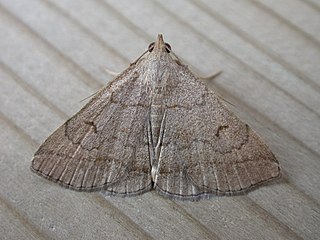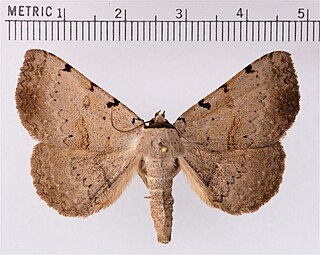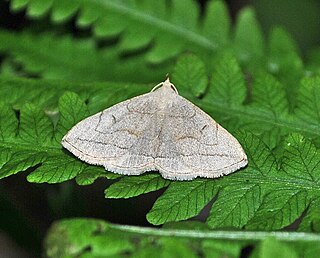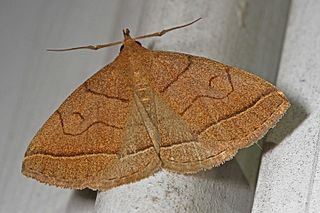
Acronicta is a genus of noctuid moths containing about 150 species distributed mainly in the temperate Holarctic, with some in adjacent subtropical regions. The genus was erected by Carl Linnaeus in his 1758 10th edition of Systema Naturae. Caterpillars of most Acronicta species are unmistakable, with brightly colored hairy spikes, and often feed quite visibly on common foliate trees. The hairy spikes may contain poison, which cause itchy, painful, swollen rash in humans on contact. The larva of the smeared dagger moth is unusually hairy even for this genus. Acronicta species are generally known as dagger moths, as most have one or more black dagger-shaped markings on their forewing uppersides. But some species have a conspicuous dark ring marking instead.

Zanclognatha lunalis, the jubilee fan-foot, is a moth of the family Noctuidae. The species was first described by Giovanni Antonio Scopoli in his 1763 Entomologia Carniolica. It can be found across the Palearctic realm.

Annaphila is a genus of moths of the family Noctuidae. The genus was erected by Augustus Radcliffe Grote in 1873.
Cleptomita was a genus of moths of the family Noctuidae first described by Augustus Radcliffe Grote in 1873.

Zanclognatha is a genus of litter moths of the family Erebidae. The genus was erected by Julius Lederer in 1857.
Megachyta was a genus of moths of the family Noctuidae first described by Augustus Radcliffe Grote in 1873.
Pityolita was a genus of moths of the family Erebidae first described by Augustus Radcliffe Grote in 1873.

Plagiomimicus is a genus of moths of the family Noctuidae. The genus was erected by Augustus Radcliffe Grote in 1873.

Spiloloma is a monotypic moth genus in the family Erebidae. Its only species, Spiloloma lunilinea, the moon-lined moth, is found in eastern and south-central North America. Both the genus and species were first described by Augustus Radcliffe Grote in 1873.

Digrammia was a genus of moths in the family Geometridae erected by Carl Freiherr von Gumppenberg in 1887. It is now often considered a synonym of Semiothisa.

Nemoria is a genus of emerald moths in the family Geometridae. It was named by Jacob Hübner in 1818.

Zanclognatha pedipilalis, the grayish zanclognatha, is a litter moth of the family Erebidae. The species was first described by Achille Guenée in 1854. It is found in eastern North America, from Nova Scotia south to Florida and Mississippi, west to Alberta and Kansas.

Zanclognatha laevigata, the variable zanclognatha, is a litter moth of the family Erebidae. It was described by Augustus Radcliffe Grote in 1872. It is found in North America from Manitoba to Nova Scotia, south to Florida and Missouri.

Zanclognatha lituralis, the lettered zanclognatha, is a litter moth of the family Erebidae. It was described by Jacob Hübner in 1818. It is found from in North America from Wisconsin to Nova Scotia, and south to Florida and Texas.

Zanclognatha martha, the pine barrens zanclognatha or Martha's zanclognatha, is a litter moth of the family Erebidae. It was described by William Barnes in 1928. It is found from Ohio to Maine, south in the mountains to North Carolina and along the Coastal Plain to Texas. It is listed as threatened in the US state of Connecticut.

Zanclognatha obscuripennis, the dark zanclognatha, is a litter moth of the family Erebidae. It was described by Augustus Radcliffe Grote in 1872. It is found in North America from Missouri to Quebec, south to Florida and Texas.
Sitochroa chortalis, the dimorphic sitochroa moth, is a moth in the family Crambidae. It was described by Augustus Radcliffe Grote in 1873. It is found in North America, where it has been recorded from Nova Scotia to southern British Columbia, south to New Jersey, Arizona and northern California. The habitat consists of grassland and prairie areas.
Stiriina is a subtribe of owlet moths in the family Noctuidae. There are at least 50 described species in Stiriina.
Stiriini is a tribe of owlet moths in the family Noctuidae. There are at least 120 described species in Stiriini.
This page is based on this
Wikipedia article Text is available under the
CC BY-SA 4.0 license; additional terms may apply.
Images, videos and audio are available under their respective licenses.












